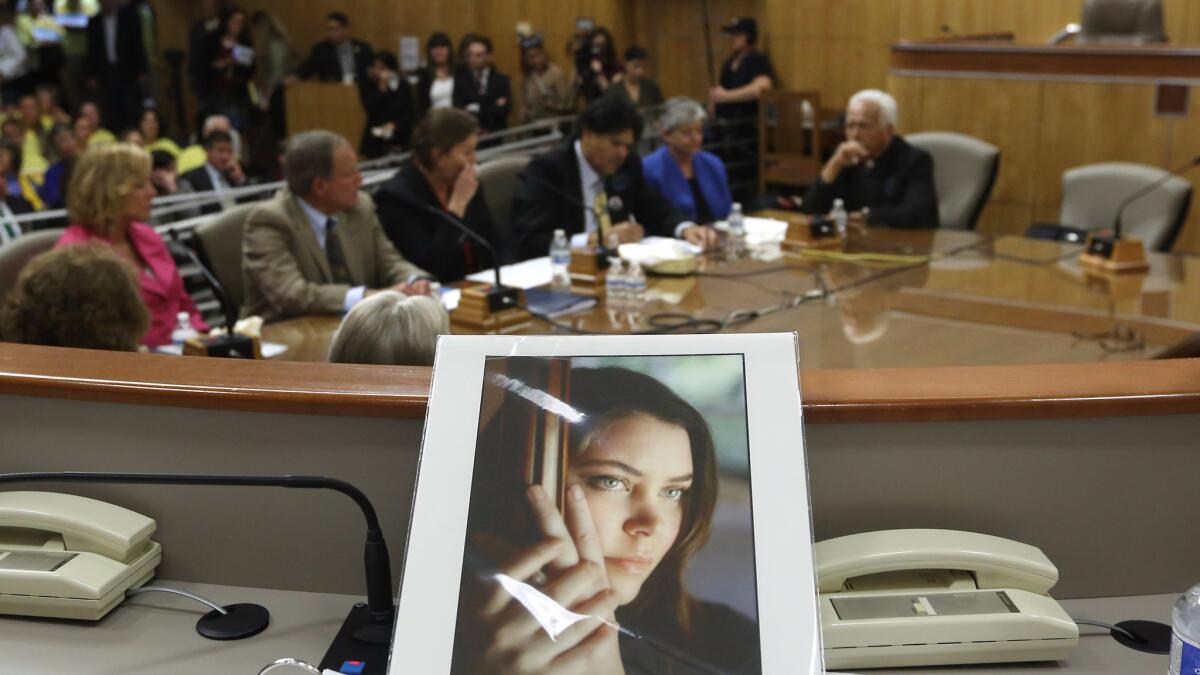Editorial: Giving patients aid in dying is compassionate care

- Share via
Thursday marks an historic day for Californians. For the first time, terminally ill patients in this state will be allowed to turn to their physicians for guidance and help on how to end their lives on their own terms. While many dying patients will not opt to take advantage of their rights under the End of Life Option Act, others facing a fatal prognosis from a brutal disease or condition will undoubtedly be comforted by the new law.
But for some physicians, this is an occasion for trepidation, because helping people die – even when they are terminally ill – is in stark contradiction to the ancient Hippocratic Oath that still guides the profession. “Neither will I administer a poison to anybody when asked to do so, nor will I suggest such a course,” says the original Greek text.
For the record:
1:57 p.m. June 24, 2016This piece incorrectly states that UCLA is covering the cost of the medication. It should say that UC Care, the University of California health plan, will cover the cost.
But attitudes about medical care have changed a great deal over the last seven centuries, including about how to provide end-of-life care. These days, many doctors believe that giving dying patients some control over how and when they die – and in how much pain or discomfort – may at times be more compassionate than merely keeping them alive as long as possible in any condition whatsoever.
To be clear, California’s new law, modeled on Oregon’s 20-year-old Death With Dignity Act, will not force doctors, pharmacists or anyone else to help a person end his or her life. Nor does it permit institutional or legal punishment against those who opt out. That’s as it should be.
But if Oregon’s experience is any guide, some doctors who object to the law will change their minds once it goes from an abstract concept to a real life. It’s harder to be resolute, advocates say, when a person you’ve treated for decades, and know to be facing a terrible end, pleads for a lethal prescription.
California, the largest state to adopt such a law, is the fifth to do so. Similar laws are under consideration in more than 20 other states.
In any case, the objection by some doctors (how many exactly is not clear) doesn’t appear to be a major bump in the roll out of the new law this week. Some of the state’s largest health facilities – Kaiser Permamente, Sutter Health, UCLA – are not only complying voluntarily, but will cover the cost of the the medication. (Individual physicians can still opt out). That’s no small thing, because the most popular medication used for physician-assisted death in states where it is allowed is Seconal, and the company that makes it, Valeant Pharmacueticals, hiked the cost of the lethal dose from $200 to $3,000 last year, just after California passed the law.
The state medical board’s website, with links to application and compliance forms, was set to go live hours before the new law kicked in Thursday. And the state Department of Public Health has been answering final questions for doctors, such as what they should report as the cause of death (answer: the underlying illness, not suicide). California, the largest state to adopt such a law, is the fifth to do so. Similar laws are under consideration in more than 20 other states.
Even the California Medical Assn., which opposed earlier versions of this law (and was neutral on the final version), has issued a voluminous and unbiased fact sheet to help guide doctors through this major transition.
The law includes substantial built-in safeguards to abuse, starting with the requirement that a patient be diagnosed by a doctor as having just six months to live, that they are mentally competent and that they are able to self-administer the medication. A second doctor must agree. No fewer than five forms must be filled out at various stages of the process, by doctors, pharmacists and the patient. After they receive the medication, patients must fill out another form within 48 hours prior to the self-administration of the drug. The option has been used sparingly in Oregon – fewer than 1,000 people in two decades.
Many more have requested the prescription, but not used it, suggesting perhaps that simply having the means to end the pain and suffering is comfort itself.
Follow the Opinion section on Twitter @latimesopinion and Facebook
More to Read
A cure for the common opinion
Get thought-provoking perspectives with our weekly newsletter.
You may occasionally receive promotional content from the Los Angeles Times.










